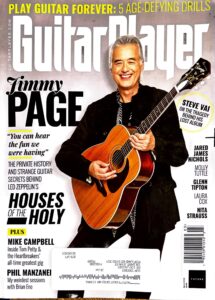How guitar shape and playing style affect shoulder impingement in the strumming arm.
Shoulder impingement in the arm of that strums, is a common issue among guitarists, and both the shape of the guitar and the player’s style can significantly influence the risk and severity of symptoms.
Guitar Shape and Size
Larger Body Guitars (e.g., Dreadnoughts, Jumbos): These require the strumming arm to reach further around the instrument, increasing shoulder abduction (lifting) and internal rotation. This position narrows the subacromial space in the shoulder, which can aggravate or cause impingement, especially during prolonged sessions 5 6 9. The internal rotation is a recipe for trouble, especially when coupled with abduction of the shoulder. If you also perform activities, like typing, chopping, or mousing, that also involve internal rotation and abduction, you are adding insult to injury. Those activities may be the “true cause(s) of the impingement, and not only the guitar.
Smaller Body Guitars (e.g., OM, 000, Parlour): These allow the arm to rest in a more neutral, relaxed position, reducing the need for excessive shoulder movement and minimizing impingement risk 5 9. If you can practice on a slim body electric, then gig on acoustic, that is also a good way to minimize risk.
Body Depth and Bout Width: Deeper and wider guitars exacerbate the need to reach, while shallower, narrower bodies are generally easier on the shoulder 5 9.
Electric vs. Acoustic: Electric guitars are typically thinner, often resulting in less shoulder strain compared to large acoustics 1 4.
Playing Style and Posture
Strumming Technique: Aggressive or wide-arc strumming, especially from the shoulder or elbow, increases repetitive stress and tension in the shoulder. Efficient technique focuses strumming from the wrist, keeping the shoulder relaxed 1 7 8.
Posture: Poor posture—such as slouching, hunching, or elevating the shoulder, while playing or otherwise—can lead to muscle tension and impingement. Sitting with the guitar too low or too high, or twisting the torso, also contributes to shoulder strain 1 2 3 6 7.
Standing vs. Sitting: Standing with a properly adjusted strap can reduce shoulder strain by allowing a more natural arm position. Sitting, especially with large guitars, often forces the shoulder into a more abducted and internally rotated position, increasing impingement risk 3 5.
Classical Position: Using a footstool or raising the guitar (as in classical playing) can help keep the shoulder relaxed and the arm in a more ergonomic position 1 6 8.
Individual Factors
Body Proportions: Players with shorter arms or limited shoulder mobility may find certain guitar shapes or positions more problematic 6.
Pre-existing stressors: Tendonitis, rotator cuff issues, or previous injuries can make the shoulder more susceptible to impingement from suboptimal playing positions 5 6 9. Additionally, any pre existing activities that stress the area could play a role as well. Pre-existing stressors in the form of sports, jobs, accidents, sleep positions, medications, weight, and the like, may all have a role to play in vulnerability and perpetuation of the current impingement injury.
Comparison Table: Guitar Shape and Shoulder Impingement Risk
| Guitar Shape/Style | Arm Position Required | Shoulder Impingement Risk | Notes |
| Dreadnought/Jumbo | High abduction | High | Large body, deep bout |
| OM/000/Parlor | Neutral/low abduction | Low | Smaller, shallower body |
| Electric (solid body) | Neutral | Low | Thinner, lighter |
| Aggressive strumming | Wide arc, tense | High | More movement from shoulder/elbow |
| Wrist-based strumming | Minimal movement | Low | Shoulder remains relaxed |
| Standing (strap high) | Neutral | Low | Allows natural arm position |
| Sitting (large guitar) | High abduction | High | Forces arm around body |
Key Recommendations
Choose a guitar size and shape that allows your strumming arm to rest comfortably, minimizing the need to reach or elevate the shoulder 5 9.
Focus on relaxed, wrist-based strumming rather than using the whole arm or shoulder 1 7 8.
Maintain good posture: keep the back straight, shoulders relaxed, and avoid slouching or hunching1 2 3 6 7.
Consider standing with a properly adjusted strap or using a footstool to raise the guitar when sitting 3 8.
Take frequent breaks, stretch, and monitor for signs of tension or pain 7 8.
Shoulder impingement in the strumming arm is strongly influenced by both guitar shape and playing style as well as previous and current stressors unrelated and related to playing. Larger, deeper guitars and poor posture or technique increase risk, while smaller guitars, relaxed wrist-based strumming, and ergonomic positioning help prevent it 1 2 3 4 5 6 7 8 9. Seeking guidance from a healthcare practitioner who has experience working with musicians and playing related musculoskeletal disorders (PRMD) is your best bet for getting better fast with the longest lasting results.
Dr. Lou Jacobs is a chiropractor and acupuncturist in Portland, Maine. He has over 25 years of experience working with musicians of all kinds, and has had the pleasure of helping some of the world’s greatest guitarists. Dr. Lou is able to consult with musicians online, and sees everyone else at his office or at the venue. To schedule with Dr. Lou call (207) SPINAL-1. Dr. Lou may have more experience with musicians than any other specialist in New England. Dr. Lou was interviewed for Guitar Player Magazine in 2023! Click HERE for the link!
Citations:
- https://www.reddit.com/r/guitarlessons/comments/xg8py5/fing_major_shoulder_pain_as_a_new_electric_player/
- https://pmc.ncbi.nlm.nih.gov/articles/PMC8726467/
- https://www.acousticguitarforum.com/forums/showthread.php?t=573841
- https://everythingsg.com/threads/neck-shoulder-pain-on-strumming-side.35880/
- https://www.thegearpage.net/board/index.php?threads%2Fshoulder-pain-acoustic-dimensions.2432919%2F
- https://forum.troygrady.com/t/rotator-cuff-aggravation/57640
- https://www.aaronshearerfoundation.org/online-supplement/guitar-shoulder-pain/
- https://www.djangobooks.com/forum/discussion/17439/sore-shoulder-deltoid
- https://www.acousticguitarforum.com/forums/showthread.php?t=200587
- https://www.youtube.com/watch?v=VPbMuoMi1YQ
- https://www.youtube.com/watch?v=pp3-03PX0B0
- https://www.jazzguitar.be/forum/everything-else/97557-fat-guitars-sore-shoulders.html
- https://www.youtube.com/watch?v=UPEZDMYv2dk
- https://acoustictalk.proboards.com/thread/52364/shoulder-pain-guitar-sizes
- https://melbourneguitaracademy.com/the-guitarists-guide-to-overcoming-arm-injuries-part-1/
- https://www.reddit.com/r/guitarlessons/comments/1d44hek/am_i_holding_the_guitar_wrong_my_picking_hand/
- https://www.youtube.com/watch?v=BCxd444psNE
- https://www.acousticguitarforum.com/forums/printthread.php?t=202958&pp=30
- https://umgf.com/what-guitar-for-shoulder-pain-t195922-s20.html
- https://everythingsg.com/threads/neck-shoulder-pain-on-strumming-side.35880/
- https://uadforum.com/community/index.php?threads%2Fshoulder-pain-from-excessive-guitar-playing.52920%2F
- https://www.ultimate-guitar.com/forum/showthread.php?t=1725396
- https://www.acousticguitarforum.com/forums/showthread.php?t=628222
- https://www.scorehero.com/forum/viewtopic.php?p=1284104
- https://www.youtube.com/watch?v=LrBxeEIMl6U
- https://tomhess.net/Articles/PrinciplesOfGoodPracticeHygiene.aspx

